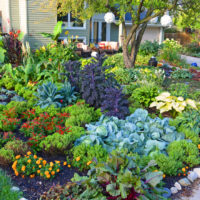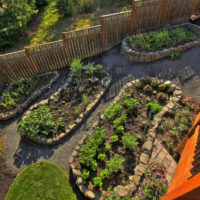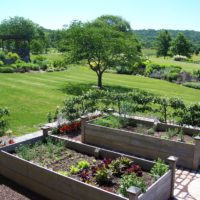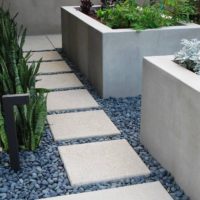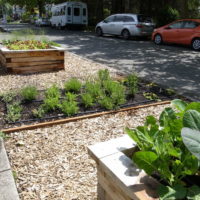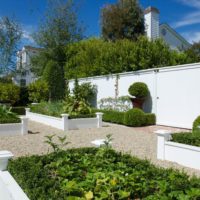Recommendations for creating a garden design project with beds
To simplify the life of the gardener, increase the productivity of crops and turn worries about the harvest into relaxation, “smart” beds for the most advanced gardeners will help. The technology of lazy beds will not let the seedlings disappear and allow the crop to live up to your expectations.

Do you want your garden to become your pride? Read our article on how to do this.
Content
- 1 Garden layout
- 2 Materials for beds
- 3 The principles of lazy beds
- 4 DIY lazy garden
- 5 High beds
- 6 Smart beds
- 7 Warm beds
- 8 DIY warm bed
- 9 Unusual solutions
- 10 DIY multi-tier bed
- 11 Tips for the summer resident
- 12 Garden decor
- 13 Single style
- 14 VIDEO: Beautiful beds - a beautiful garden with your own hands!
- 15 50 design options for a garden with beds:
Garden layout
With the right approach, the garden can become not just a place for growing vegetables, but also turn into a stylish object of landscape design. Specialists in this field have developed many recommendations in this regard.

How to arrange beautiful beds for the lazy, beds high and smart - this is what the gardener needs to know.
- When planning the installation of a garden, pay attention to the fertility and illumination of the place for beds.
- Prioritize the quality of the beds, not their quantity. A few neat beds will look much better than a vast garden overgrown with weeds.
- Use space tiers to save space.
- Framing the sides will help improve the crop and give the beds an aesthetic appearance. For this purpose, stone, pavers, colored slate, plastic fences are perfect.
- The optimal width of the paths between the beds is 70 cm.
- In order to prevent the plants from blocking each other, arrange them from north to south on a flat area, in a territory with a slope - perpendicular to it. At the same time, the southern slope is preferable for vegetable crops, and the northern one for garden crops.
- Do not limit yourself to rectangular shapes. The beds can be made in an arcuate or in the form of various geometric shapes, arranged in groups or create a single composition.

Summer residents grow many crops that have similar characteristics of growing or, conversely, contradicting each other.
Materials for beds

By zoning the plot with the help of beds, incompatible plant species can be separated or those that are characterized by the same care system can be combined.
| Material | Benefits | disadvantages |
| Tree | Easy to create, mobile, easy to disassemble and carry | Susceptibility to decay |
| Straw | Originality | Fragility |
| A rock | Durability | High price |
| Plastic | Easy installation and maintenance, resistant to sun, cold, moisture | Do not always fit into the overall style of the site |
| Metal | Durability | Requires additional precautions |
The principles of lazy beds
The main principle of the new approach to gardening is to dig and weed the ground only during preparation and planting, otherwise it will dry quickly and will not be able to provide the crop with moisture. Only surface loosening is allowed.
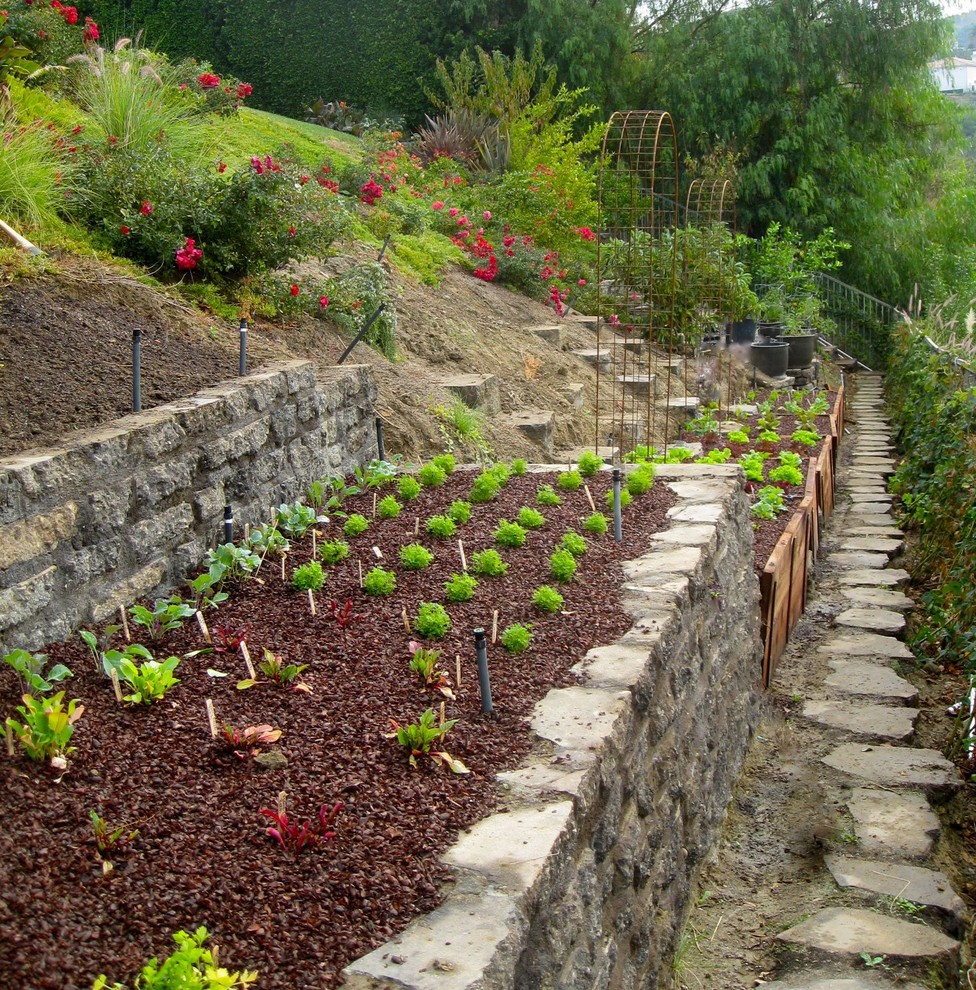
Lazy beds - a completely new approach to the care of the garden, which will allow seedlings to grow on their own and will give several times more crop.
You need to start preparing the beds in advance.Collect straw, sawdust or cones, cover them with a surface so that it is difficult to grow weeds in this area. This procedure is called soil mulching. It is thanks to her that the beds will no longer have to weed.

The rule says that you can’t dig and weed the ground, except for its preparation and planting itself.
Progressive summer residents have long appreciated the charm of an automatic irrigation system, which allows you to save your time without compromising the crop. With the click of a button you can start the watering process, and your beds will remain lush and green without much effort on your part.

Even if weeding can be removed and the soil is fluffed up, it will dry sooner or later and will not be able to produce enough moisture for the crops.
DIY lazy garden

Homemade fencing is an easy way to build a foundation for a garden bed.
- Determine the desired height of the sides.
- Connect the boards with a screwdriver, remove the clamps.
- Turn the bed over, replace it. Make sure that the illumination here is sufficient for seedlings to germinate.
- Dig the corner bars 12-15 cm into the ground.
- Adjust the edges using the building level. This is necessary for the proper operation of the irrigation system.
- Install plastic tubes from the inside so that the walls do not collapse from the weather.
- Level the platform, cover it with a net from moles.
- Fill the soil.
- Secure the irrigation system.
- Plant seedlings.
- Install an awning if necessary.

In this approach, preparation for a future landing is very important - it is advisable to do this since the fall.
High beds
Poor climate and low productivity will become forgotten problems for you due to the high design of beds. Their creation is quite laborious, but the result will pleasantly surprise you.
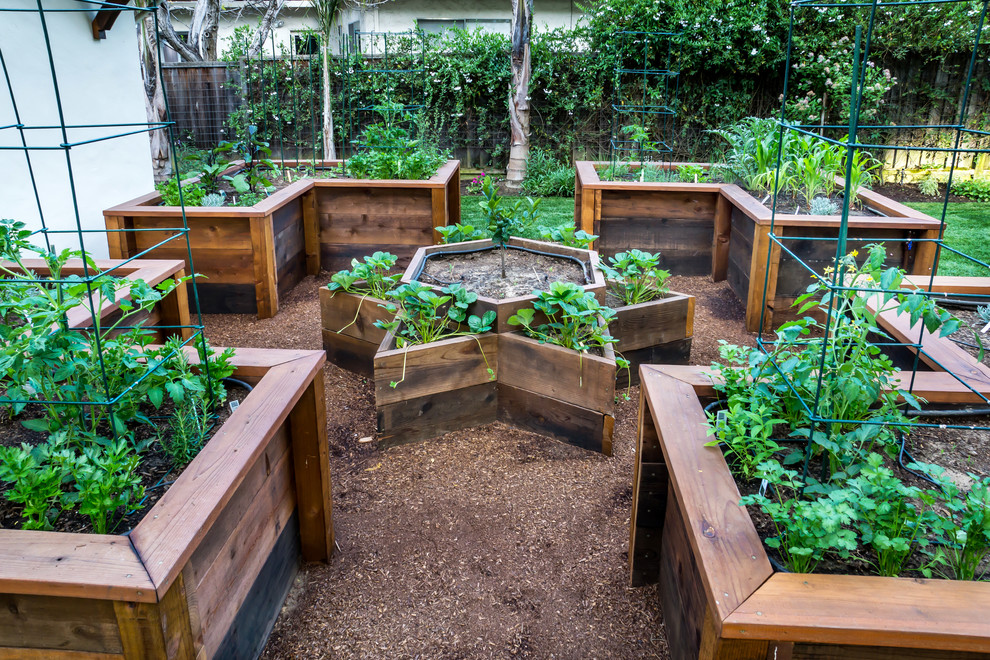
Although this is a very time-consuming process at first - building the frame itself and watering the beds, but it is it that will allow you to forget about the poor climate and low productivity.
The advantages of such beds.
- Good soil warming due to the proximity of the sun. You can plant them in April.
- The lower net will protect the crop from moles and rodents.
- A frame with a width of about 1.5 m will provide ease of irrigation, since it will be possible to approach it from both sides.
- Dividing it into two parts, you can easily organize a greenhouse do it yourself.
- Harvest on high beds appears earlier than on ordinary ones.

A high bed is always under the rays of the sun, which contributes to the warming of the earth, so it can be planted in April without fear of freezing.
However, one drawback of this design is the need for frequent watering due to the fact that moisture quickly goes down.
The most popular materials for making high beds are:
- Barrels made of aluminum;
- A rock;
- Brick;
- Logs.

It is worth noting that it is high beds that give the earliest harvest first of salads, and then picky vegetables.
They are made in the form of ridges or trapezoids. They are created for one season, since under the snow in the winter they noticeably settle. Applied mainly for gourds - cucumbers, pumpkins, zucchini. Sometimes they plant potatoes.
Smart beds
The main principle in smart beds remains the same as in lazy ones, but the emphasis is on fertilizers. The quantity of the crop and how carefully it will be necessary to care for it depends directly on their quality.

Smart beds need to be dug up only once. Weeding they do not need - the mulch will not let the weeds rise.
The soil in them is a compost consisting of straw, leaves and sawdust containing nutrients. A thin layer of soil is laid on top of it, and after a couple of weeks the bed can be planted.
Warm beds
The principle of constructing warm beds is based on the layering and location of fresh manure in their lower layers. In winter, the main processes are launched, and by the spring it begins to decompose.Rotting, manure emits heat, and the bed early becomes ready for planting.

Many gardeners have repeatedly been convinced that high-quality fertilizer gives a large crop that does not require much effort from its owner.
This method is suitable for radishes, cucumbers and other crops with shallow roots.
DIY warm bed
After pre-sampling the soil at 40-50 cm, we lay the layers in the following sequence.

Such a bed does not use ordinary soil as soil, but compost, which is based on straw, leaves and sawdust, which as a result gives even more useful substances for future plants.
- Large wood
- Fine wood
- Land
- Organics - Waste
- Sprinkle EM-Bokashi, pour EM-A
- Earth again
- Organics - Waste
- Sprinkle EM-Bokashi, pour EM-A
- Humus
- Mulch (5-8 cm)

The life of such beds is 6-8 years.
Unusual solutions
The garden does not have to be boring at all, because there is easily a place for manifestation of imagination and originality.
Hanging beds
To create unusual beds that will give the garden an original look and save the space of the site, you can do it yourself. You can make them from bags or plastic pipes cut in half. Plant in them strawberries, herbs or small vegetable crops.

Your site will be filled with meaning and you can give it personality.
Another advantage of this design is that you can plant seedlings in them in advance, and take them out into the street when it gets warmer.
Vertical beds
Another way to save space - vertical multi-tiered beds. Wooden boards, boxes and plastic pipes will be an excellent material for creating such structures do it yourself.

The arrangement and shape of the beds - depending on your imagination and the convenience of getting around them.
Beds from improvised materials
The most familiar things can be adapted for containers for planting vegetables:
- Baskets;
- Boxes;
- Watering can;
- Old chest of drawers;
- The dishes;
- Car tires;
- Unnecessary boots and boots;
- Wooden barrels;
- Bathtub;
- Bicycle.

Framing the beds is not only the key to a good harvest.
You can build a flowering garden even from a pair of old jeans. And decorating tires, you can create the most unexpected compositions in the form of animals, flowers and heroes of your favorite cartoons.
DIY multi-tier bed
Make a classic square three-level bed do it yourself pretty simple. Pre-outline its location and draw up a plan on paper, taking into account the characteristics of the planned vegetables, the number of tiers, size and topography of the site.

Combining certain crops on one bed will create an amazing floral design.
- Level and mark the surface.
- Treat the boards with antiseptic impregnation.
- Mount the sides with a height of at least 15 cm, observing right angles. Remember that the following levels will be lower in height. Therefore, it is better to choose a height with a margin.
- Connect the boards to the boards with the help of bars with sides of 50 cm.
- Lay polyethylene or metal mesh on the ground, cover it with drainage, then with soil, and then with compost.
- The second level is set on top. It should occupy 2/3 of the lower tier. Layers are stacked similarly to the previous one.
- The third level is made even less: it takes 1/3 of the first tier.
- At the final stage, paint the outer walls of the beds with wood paint.

The composition may consist not only of vegetables, but also of herbs, flowers. Some types of plants are able to provide vegetable crops with protection against pests and diseases.
Tips for the summer resident

The space between the beds can be filled with pebbles or shared by small paths.
| Task | Decision |
| Pick inventory | Do not save on tools. Cheap equipment will quickly become worthless, and you will need to buy a new one. Therefore, it is better to immediately choose quality things. |
| Arrange storage |
|
| Effectively combine cultures with each other | Play on contrasts and shapes. Combine climbing plants with dimensional zucchini and watermelons or use the same cultures, but in different colors. |
| Pave paths between the beds | Lay them out with pebbles, concrete tiles, lawn grass or wooden saw cuts. |
| Handle wood fencing | The most economical way: use copper sulfate on the inside, and lime on the outside.
The most durable: terrace deck. |
| Create a spectacular garden design | Choose a single style. For the garden are perfect: Mediterranean, Japanese, country. Choose the appropriate borders, patterns from the beds and garden figures. |
Garden decor
Decorative elements are something without which it is impossible to imagine a stylish garden. A small mill, a garden gnome figurine or an animal-shaped figurine, as if an accidentally forgotten watering can or a cart wheel — all these little things will complement the design of your site and it will sparkle with fresh colors.

The design of the beds can be the most diverse, it all depends on the imagination.
No one forbids combining vegetables with garden plants. Flower beds, arches, trellises and “huts” entwined with curly flowers will perfectly fit here.
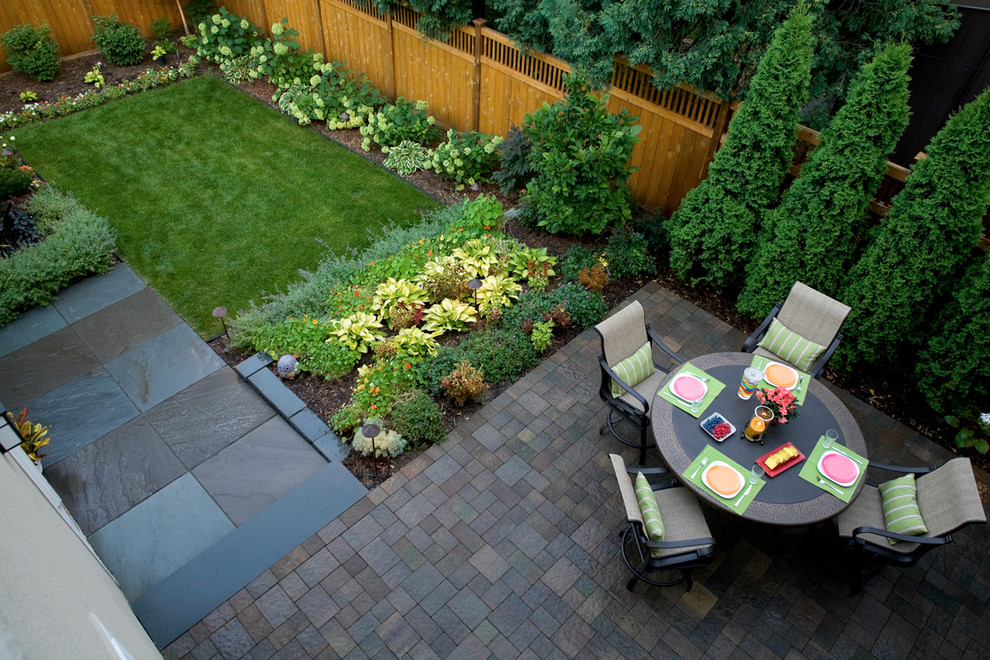
To diversify the appearance of plantings, you can add flowers, for example, marigolds to vegetable crops.
Single style
We bring to your attention the most popular solutions for the design of the garden in the general style.

Choose contrasting plants in shape and color, don't be afraid to experiment!
| Style | Colors | Materials | Features |
| Mediterranean | Pastel shades, terracotta, ocher | Natural stone, paving slabs, wooden flooring, brick |
|
| Country | Colorful natural shades | Natural wood, stone, willow twig |
|
| Japanese | Green palette | Fine crushed stone, pebbles, boulders |
|
| French | Delicate natural colors | Almost any: wood, stone, brick, slate, concrete |
|
A stylish garden with a unique design will be the pride of any summer resident, and smart technology, high beds and the right choice of soil will help increase productivity and save the effort and money spent on care.
VIDEO: Beautiful beds - a beautiful garden with your own hands!



